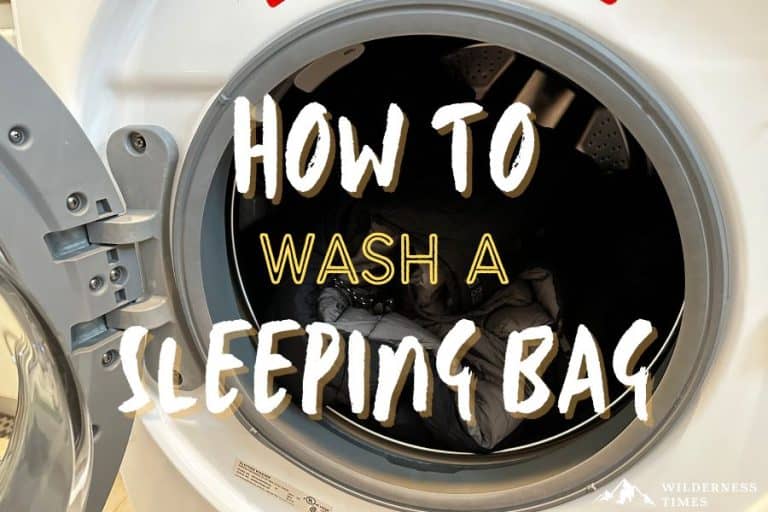Let’s face it – camping isn’t always the cleanest activity.
All it takes is a little bit of rainfall, and the next thing you know, you and all your gear are covered in mud–including your sleeping bag.
Plus, sleeping bags can just get dirty after repeated, normal use. That’s why it’s important to be aware of how to properly take care of your sleeping bag.
Washing your sleeping bag improperly can cause undue wear and tear if you’re not careful.
But never fear! We’re here to help you give your sleeping bag a good washing through this comprehensive guide on how to wash your sleeping bag the right way.
By the time you’re done reading this article, you’ll know everything there is to know about how to wash a sleeping bag.
Ready? Let’s go!
Table of Contents
ToggleGeneral Tips For Washing Your Sleeping Bag
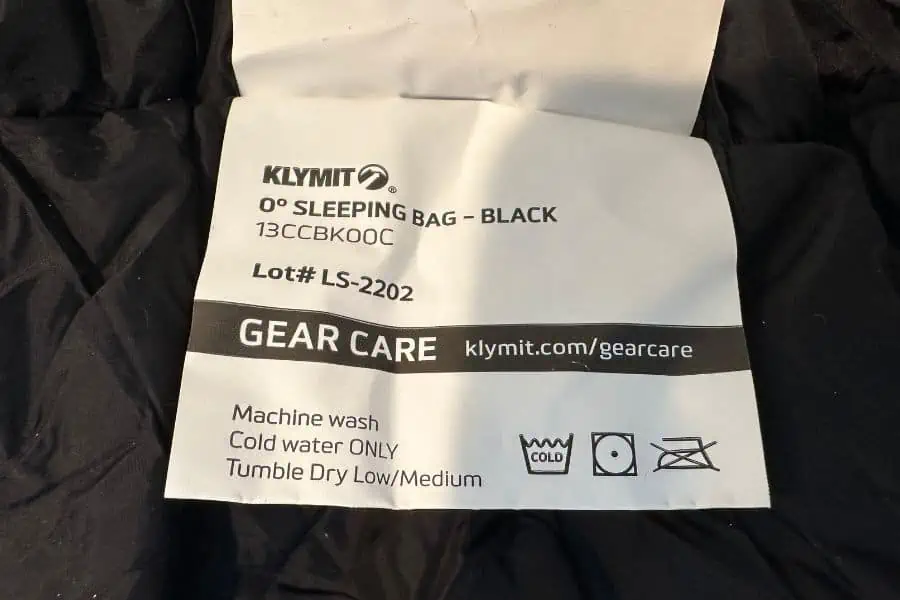
The most important thing you can do when getting ready to wash your sleeping bag–and I can’t stress this enough–is to read the washing instructions on your sleeping bag’s tag.
Why is it important? This tag will tell you whether or not you can machine wash it, what temperature it should be washed at, and more.
Basically, this tag is the holy grail on what you can and cannot do when washing your specific sleeping bag.
Don’t know if it can be machine-dried? Look at the tag.
The second most important thing is to make sure to use the right kind of soap. Unfortunately, your bag tag can’t do that for you.
Ultimately, stay away from using harsh detergents and chemicals when washing your bag.
Using the wrong soaps could not only harm the insulation but could also completely strip the durable water repellent (DWR) that keeps the bag waterproof.
Simple home detergents, like fabric softeners and bleach, could damage the fill and lining significantly.
For the same reason, never take your sleeping bag to the dry cleaners. Their cleaning chemicals will likely damage the bag.
There are some dry cleaners that specialize in sleeping bags, so those are fine. Just avoid your average neighborhood dry cleaner.
Your best option is to find a detergent specific to washing sleeping bags, like Nikwax’s Down Wash Direct (for down bags) or Tech Wash (for synthetic).
This way, you’ll know your soap is safe to use on your bag.
Lastly, it’s a good idea to repair any damage to your bag before washing it, especially if you’re going to be putting it through the washing machine.
Rogue zippers or lining holes could lead to more damage to your bag, so better to do those repairs sooner rather than later!
Washing Synthetic Vs. Down Sleeping Bags
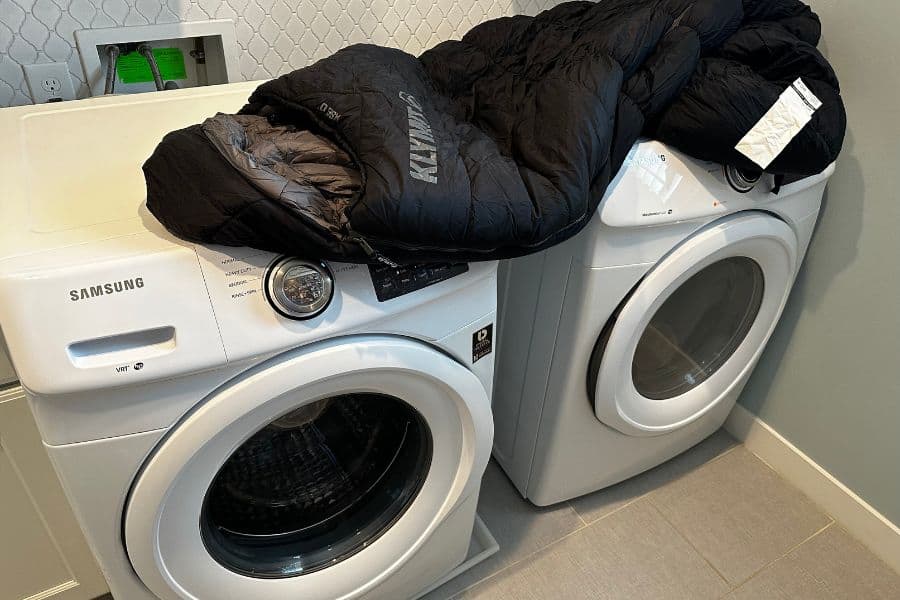
If you don’t have a washing tag to instruct you on your sleeping bag’s care instructions, you can determine its needs by considering its fill type.
The first thing you have to take into account when washing your sleeping bag is whether it has a synthetic fill or a down fill.
Synthetic Fill Sleeping Bags
If you have a synthetic sleeping bag, you’ve got a slightly easier task on your hands.
The only real precautions you need to take are to use a mild, non-detergent soap and to make sure to rinse it well.
You could also use a special soap for synthetic insulation, if you’d prefer.
If you’re washing your sleeping bag in the washing machine, run it through an extra rinse cycle at the end to make sure there isn’t any soap left in the fill.
Down Fill Sleeping Bags
Washing a down-filled sleeping bag is a bit trickier. If you’re not careful, your down bag could take a battering in the wash.
The first trick to properly washing a down sleeping bag is not to wash it too often. Only wash it when it really needs it.
Too-frequent washing is likely to decrease the effectiveness of the bag’s insulation and waterproofing.
Also, unlike synthetic sleeping bags, you can’t just use any detergent-free soap. When in doubt, use a specific down-friendly soap.
How To Wash A Sleeping Bag
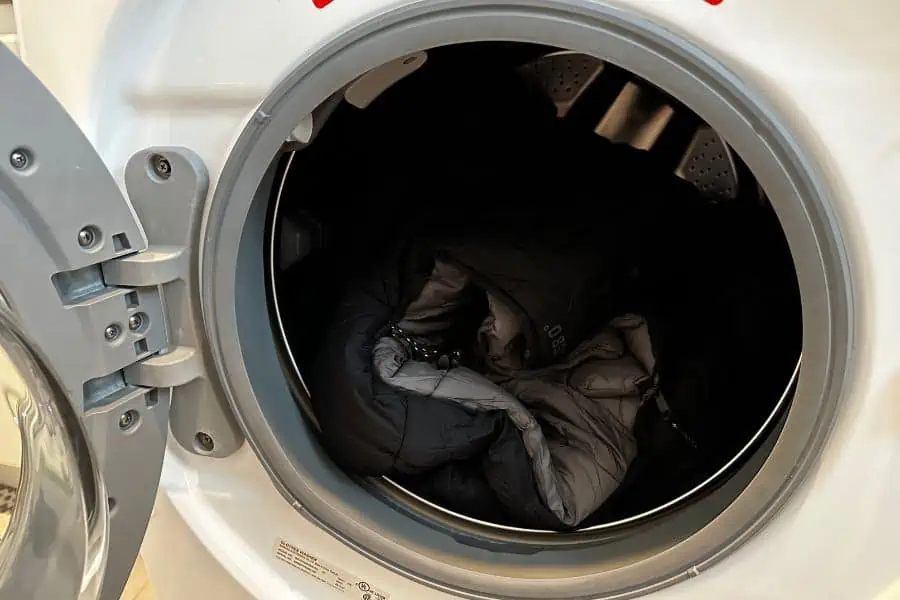
There are two different ways you can go about washing your sleeping bag: in the washing machine or by hand.
There are pros and cons to each method, and they can vary depending on which sleeping bag you have.
But if you have the option, here are the steps to both ways:
How To Machine Wash A Sleeping Bag
When it’s time to wash your sleeping bag after a long camping trip, the easiest thing to do is throw your sleeping bag in the washing machine.
Be careful, though. A washing machine is going to be much tougher on the bag than hand washing.
You’ll need to be extra careful about machine settings, extra rinses, and bag repairs.
Aside from that, here is how you wash your sleeping bag in the washing machine:
Step 1: Check Your Bag’s Instructions
It’s been said several times but be sure to check your sleeping bag’s washing instructions to see if it recommends being machine washed at all.
If it says no, you should consider hand washing it or finding a special sleeping bag cleaning service.
Step 2: Zip Up Your Bag
To avoid any unwanted snags or broken seams after its wash, be sure to do up all zippers, buttons, and velcro on your sleeping bag.
If your bag has a waterproof lining or shell, it is a good idea to turn it inside out, so the lining rests on the inside of the pocket.
Step 3: Add Your Special Soap & Set Your Machine
Now it’s time to put your detergent-free soap into the washing machine.
If you have a front-loader, then you’re golden. Because they have no agitator, they are less likely to damage your sleeping bag.
If you only have a top-loader, be extra cautious. Some top-loading machines don’t have an agitator, which is preferable.
Laundromats are also a great option if you do not have an agitator-less washing machine.
They will usually have a large-load machine, which would be very helpful in washing your sleeping bag. You don’t want it too cramped!
Once your soap and sleeping bag are in the machine, set it to its most delicate cycle and whatever temperature was recommended on your tag.
Most often, cool-to-warm water is what is recommended. If you are unsure of what to use, go for the lowest temperature setting.
Step 4: Rinse It Again
Once the wash cycle is done, run an extra rinse cycle to be super sure there isn’t any soap left over in the fill.
If you aren’t sure if there is any soap left, give it a good squeeze. If you see bubbles, rinse it again.
Residual soap in the fill can cause your sleeping bag to lose some of that cozy loft and can cause clumps of fill to stick together.
Step 5: Take It Out
Once you’re sure all the soap is out, carefully take your sleeping bag out of the machine.
Make sure to support it from underneath to avoid straining the fabric and potentially damaging the seams.
Now it’s nice and clean, and it’s time to dry!
How To Wash A Sleeping Bag By Hand
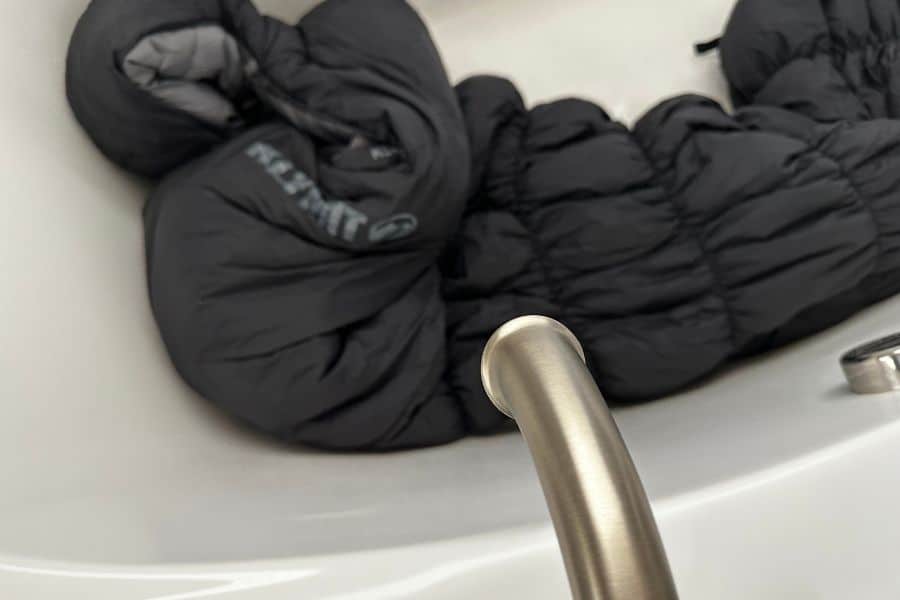
Washing your sleeping bag by hand is definitely the more labor-intensive option.
However, it is a much safer way to wash your bag and make sure it doesn’t get damaged in the process.
I recommend using your bathtub, as it’s the perfect size, and you’ve got running water that goes directly into it, which is super convenient.
Step 1: Wash Your Tub & Fill It Up
It may seem unnecessary to rinse your tub before washing something in it, but trust me, the last thing you want is to just put more dirt and grime in your sleeping bag.
Once that’s done, fill your tub with warm water (not hot) and whichever soap you’ve elected to use until you’ve got enough water to submerge your bag.
Be sure to give the water a decent stir to get the soap evenly distributed.
Step 2: Soak Your Bag
Place your sleeping bag in the tub and rub it against itself in a few places, making sure the soapy water drenches it completely.
You’ll want to let it soak in the lukewarm water for about half-an-hour to an hour.
If you find there are any stubborn spots or stains, this is the time to grab your softest cleaning toothbrush and gently scrub them away.
Step 3: Rinse & Repeat
After about an hour, and once you’re sure those spots are gone, empty the tub and fill it up again with clean water.
Take both ends of the sleeping bag and rub them against each other to start working some soap out.
Don’t try to wring the soap out or squeeze it too hard. A gentle massage is all that’s needed here.
Repeat this until there are no longer any visible soap suds left. It’s important that you don’t leave any soap in the insulation, so rinse thoroughly.
I like to give my sleeping bag a couple of extra rinses even after I can’t see any more soap, just in case.
Step 4: Get Rid Of The Excess Water
When you’ve gotten all the soap out of the bag, drain the tub and use your hands to gently press as much excess water out of the bag as you can.
Push down on the bag with your hands or fists. Whatever you do, don’t wring it out, as it can tear the seams.
Once you’ve gotten as much of the water out as you can, you’re good to set it up to dry.
Tips For Spot Cleaning
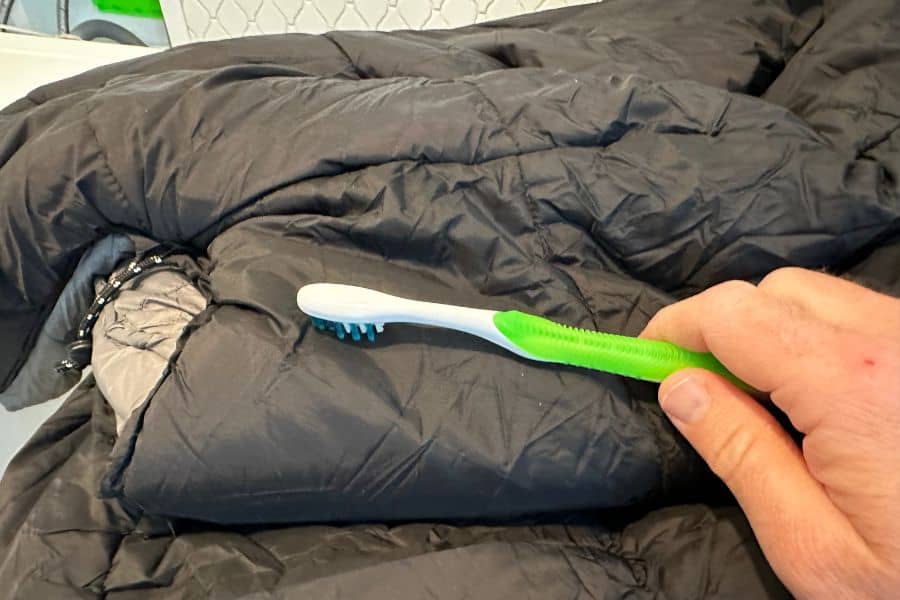
Most of the time, it isn’t necessary to wash your whole bag. This is where spot cleaning comes in handy.
Spot cleaning is great if there are certain parts of your sleeping bag that are particularly dirty–like the hood, where hair oils can collect.
It is better to spot clean more often as a first defense way of cleaning because washing too often can wear down your bag’s longevity.
You can spot clean either before you wash your bag in the machine or while you’re hand washing it.
Step 1: Gather Your Soap, Water, & Toothbrush
Apply some of your detergent-free soap and a little bit of warm water directly to the area you want to clean.
With some soaps, you create a paste by mixing the raw soap and some water, which can be easier to apply in small amounts.
Step 2: Gently Brush Away The Stains
Once you’ve applied it to the bag, use a soft toothbrush to softly rub the soap into the fabric.
Depending on the depth of the stain or spot, this can take a while, but remember to go slowly and gently.
Step 3: Wipe Off The Soap
When you’re done scrubbing, use a wet sponge to wipe off the soap.
Avoid a too-damp sponge so you don’t accidentally soak the insulation beneath it with soapy water.
If you manage to scrub without getting your insulation wet, it shouldn’t take long to dry.
However, if your insulation does get wet, make sure it dries completely before packing it away
Drying Your Sleeping Bag
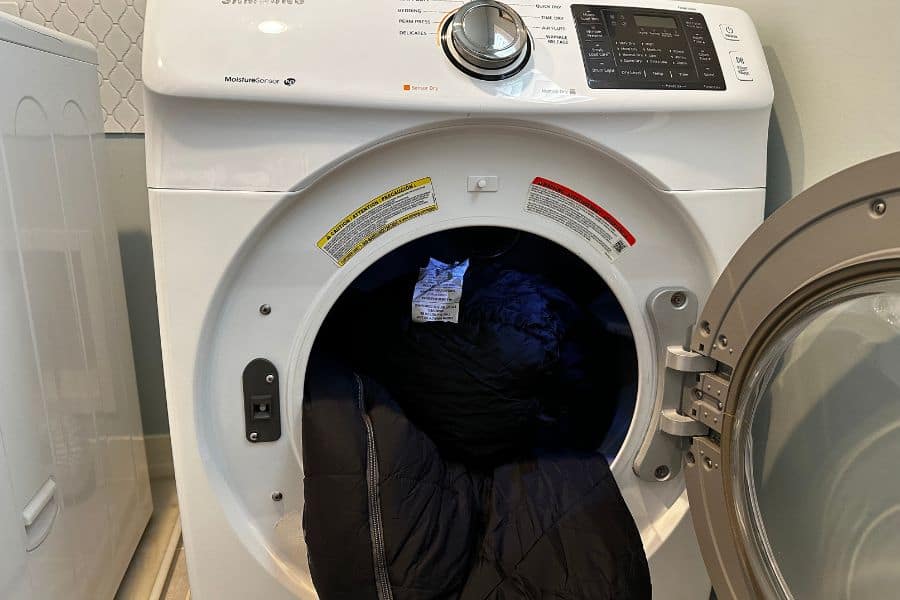
When it comes to drying your sleeping bag, there are a couple of ways you can go about it.
You can either hang it up and let it dry naturally, or you can speed things up by using a tumble dryer.
Which one is better for your bag, though? Here are the pros and cons of each:
Air Drying
Hanging your sleeping bag up and letting it naturally air-dry is definitely the safest way to do it.
You’re far less likely to damage your sleeping bag by air drying it than if you were using a machine dryer.
On the downside, it takes way longer. You’ll need to leave your bag hanging for at least a couple of days before it dries completely.
Synthetic sleeping bags typically take less time than down bags, but you want to be extra sure there is no moisture in them before storage.
You also shouldn’t try to dry your sleeping bag in direct sunlight because UV rays can damage the fabric.
If you do decide to hang it up to air-dry, either hang it up inside or in a shady spot away from the sun’s rays.
In The Dryer

If you’re using a dryer, you’ll be able to dry your sleeping bag significantly faster than air-drying it.
A down bag will take between 2-3 hours to dry, and a synthetic bag will only take about an hour.
You just have to be careful when tumble drying as it can snag the fabric or melt the insulation if it is too hot.
Use a front-load dryer if possible, and run it on the lowest heat setting. Like with the washing machine, make sure it is big enough for the sleeping bag.
If the dryer you have at home doesn’t fit this description, you should be able to find one at your local laundromat.
Also, throw in a couple of tennis balls or wool dryer balls. This will help keep the insulation fluffed and evenly distributed (plus dry it faster).
You can do this with synthetic bags, but with down sleeping bags, it’s a must.
Lastly, avoid using dryer sheets for the same reason you avoided fabric softeners: the chemicals are too harsh for the fabric on most sleeping bags.
Sleeping Bag Storage Tips
Before storing your sleeping bag, make absolutely sure it’s 100% dry. A wet sleeping bag will breed mildew and bacteria.
If there’s any moisture left when you pack it away, it’s not going to smell pretty the next time you unpack it.
Once it’s completely dry, you can pack it away, but don’t put it back in its stuff sack.
Keeping a sleeping bag compressed for long periods of time can diminish the effectiveness of the insulation.
Instead, hang your bag up in a closet or fold it loosely and store it with the rest of your bedding.
If you’re having a hard time getting your sleeping bag to fold nicely, check out our guide on how to fold a sleeping bag.
FAQs
Can you put a sleeping bag in a washing machine?
While not every sleeping bag is meant to be put in a washing machine, most can! Some brands recommend hand-washing just to maintain your sleeping bag’s life.
If you’re in doubt about whether or not your sleeping bag can be machine-washed, look at the tag or care instructions.
How often should I wash my sleeping bag?
Most often, spot cleaning will do the trick after your typical camping trip. However, they sometimes just need a good, deep wash.
A good routine is to wash your sleeping bag about once a year, after the end of your typical camping season.
If you are a more frequent camper and get more use out of your bag than most, you may wish to wash it 2-3 times per season.
How do I get rid of mildew smell in my sleeping bag?
Smells are not uncommon when it comes to sleeping bags. They are meant to spend time outside, after all!
Typically, the first thing you can try is to lay it outside to air it out. This will help the remaining dampness evaporate, which may help the smell.
If you are still experiencing a musty odor, wash your sleeping bag with vinegar. It will help kill the bacteria and overtake the smell.
That still didn’t work? Douse the bag in vinegar, let it sit, then wash it.
If you still have a problem, you may need to call in professional reinforcements.
Should you unzip a sleeping bag to wash it?
No, you should not unzip your sleeping bag when washing it. The shell of your sleeping bag is rather delicate, and its zippers are not.
Leaving your bag unzipped while in the wash heightens the chances of your bag ripping or getting snagged on itself.
So, it’s best to keep your bag in its zipped status so you don’t have to do more repairs after the wash.
When should I replace my sleeping bag?
A good sleeping bag can last you for many, many years if it is well-kept.
They are ultimately meant to keep you warm and comfortable in the outdoors.
So, when you notice the insulation and fluff are no longer doing those things, and a good wash doesn’t bring it back to life, it may be time to consider getting a new one.
How do you wash a sleeping bag without ruining it?
The best way to ensure a non-ruined sleeping bag is to hand wash it or machine wash it with a front-loading washing machine.
You should also make sure to use the right soap without harsh chemicals and rinse the bag thoroughly until there is no chance of soap left in the bag.
At the end of the day, follow the care instructions for your specific sleeping bag, and it will remain unruined and smelling fresh.
That’s All Folks!
Ultimately, when it comes to washing your sleeping bag, the safest way to wash your sleeping bag is to hand-wash it and hang it up to dry naturally.
This takes quite a bit of time and effort, though.
If you haven’t got the time or energy, machine washing is perfectly safe for most sleeping bags.
Just make sure you’ve read the tag and you’re using the right kind of soap.
If you follow these tips, your sleeping bag will be looking brand-new and smelling lovely for your next trip.
More Gear Cleaning Tips
To find out more about cleaning your camping gear, check out some of our other articles, like this one on cleaning your hiking backpack.


